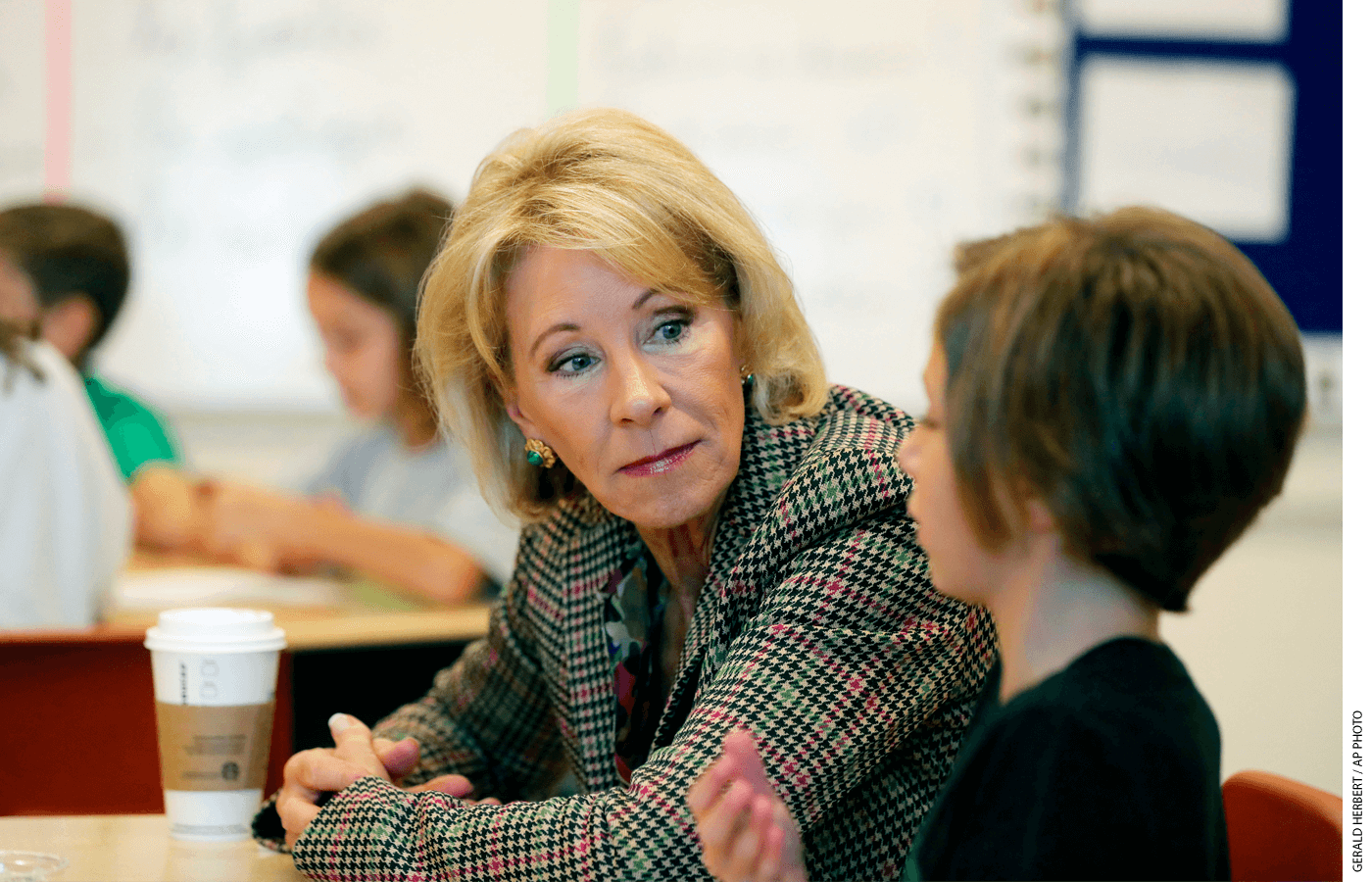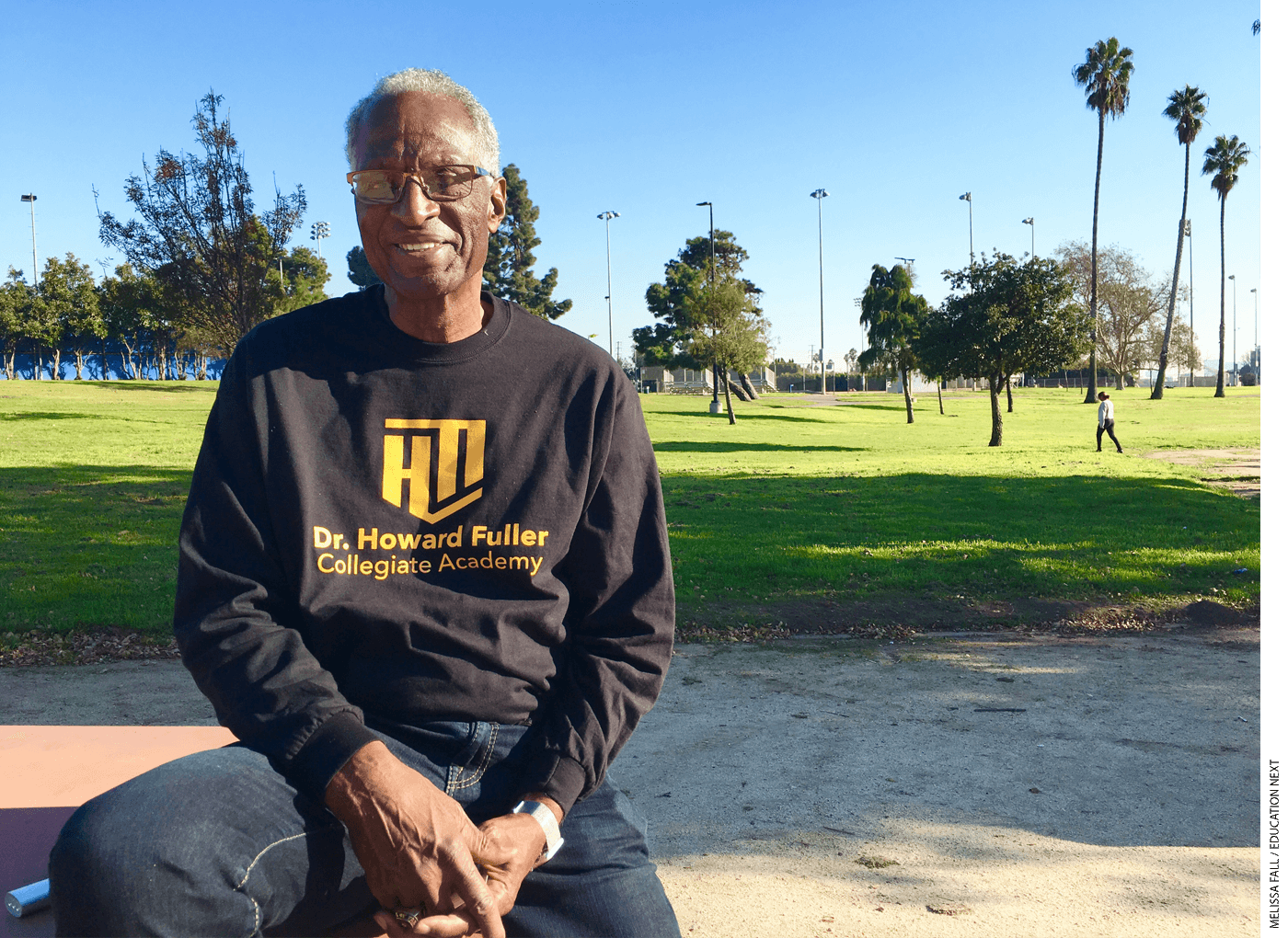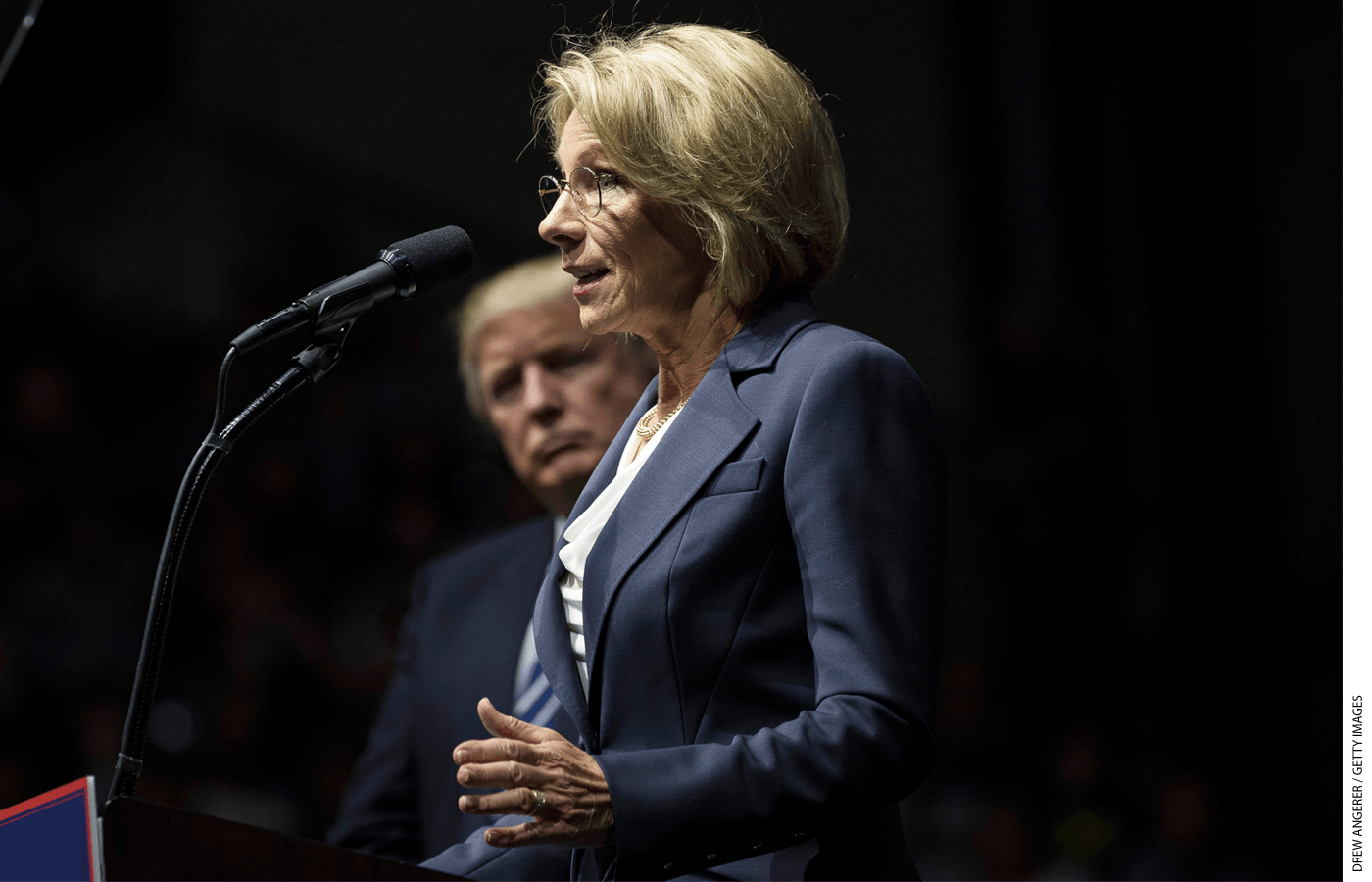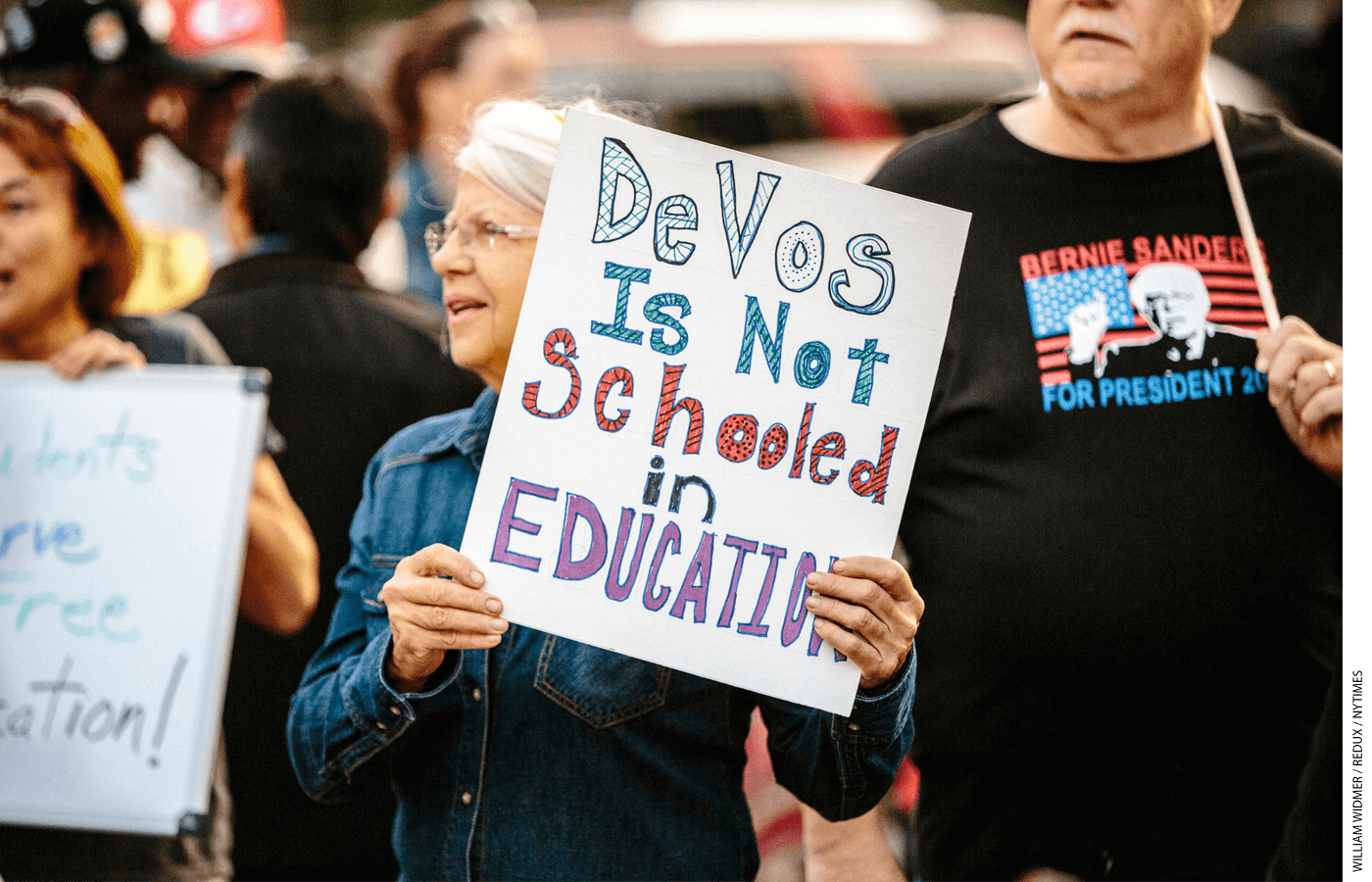
My job as Betsy DeVos’s assistant secretary for policy often came down to translating her reform vision into concrete legislative proposals, budgets, and grant competitions. It was a stimulating, enjoyable job—despite the constant tumult created by the unconventional president. There was also some unpleasantness because of the conventional labor unions that represent teachers in collective bargaining and elections, as well as their Democratic allies in Congress. That was just an expected part of the job.
I had known and admired Betsy DeVos for a couple of decades before our time together in D.C., so none of her positions surprised or disappointed me. That’s a risky thing to say, given how partisans on both sides have distorted her views, but it is an important point given what did surprise and disappoint me. Even after developing a pretty good understanding of the factions within education reform over 25 years, I was astounded by the intensity with which so many reformers opposed Betsy DeVos.
As secretary, DeVos unmasked tensions and disagreements within the education-reform community. In some ways, that was healthy, but our open conflicts did give an advantage to the defenders of the status quo and hampered reformers’ efforts to effect policy changes. In comparison to the concerns about the status quo, such policy differences should pale.
To be clear, I am not advocating for a reform orthodoxy. Given the range of informed thinking on complicated issues like federally mandated assessments or public charter schools, orthodoxy is neither beneficial nor even possible. My purpose here is not to settle scores or defend every aspect of DeVos’s record. I do hope a better understanding of the divisions within the reform camp will equip us to avoid being divided and conquered. It should increase the likelihood of success in improving the education system.

Defining Education Reformers
Let’s start with the common denominator among reformers. We all believe that the current education system needs to be reformed, transformed, or whatever nomenclature you choose. We believe the system is failing to educate sufficiently a substantial portion of children. As a result, a large number of children do not reach their potential as adults—never really succeeding in the workplace, never contributing to their communities, and never leading truly fulfilling lives. This isn’t only bad for those individuals; it’s also bad for communities, the country, and the world.
For those of us committed to equal opportunity in America regardless of class, race, gender, or beliefs, the outcomes of our education system are especially disturbing. It appears that our schools systemically fail our low-income, African American, and Latino students, notwithstanding vigorous enforcement of federal civil rights laws over nearly 60 years. Some say that our education system is a manifestation of systemic racism. Others, like me, see evidence that our system reinforces racism and might even be a source of it.
Reformers also do not believe that the current system will ever successfully educate all children to their full potential. The status quo is mostly a one-size-fits-all model from the industrial era, where instruction is aimed at an “average” student and provided by an “average” teacher. In practice, in this system, some students were highly educated and others, not so much. The system might once have served America well, but it does no longer.
This core belief that our system is antiquated and inadequately meeting America’s needs has caused some reformers, including Betsy DeVos, to call for a total reimagining of the system. When the goal is to educate fully each and every unique child, why do we maintain age-based classes or seat-time rules? Why do we resist moving to a mastery-based system? Why do we obsess on limited academic content, when we know that successful adults also need critical-thinking and social-emotional skills and behaviors?
Some reformers, particularly those that run excellent public charter networks in low-income communities, are not completely convinced that the industrial model is hopeless. They have shown that they can dramatically improve some outcomes within the traditional model by raising expectations, attracting top teaching talent, personalizing instruction, and making 100 other one percent changes to classrooms, schools, and networks. These colleagues should be welcome within the big tent of reformers, because they also despise the status quo, and because we benefit from a variety of approaches to moving beyond the status quo.
If you’re a visible education reformer, you have undoubtedly been accused of wanting to destroy or defund public education. It’s worth saying: the opposite is true. Reformers believe in public education—especially the core commitment that society (taxpayers) should foot the bill for it. (Public money is, after all, what makes it public.) Education is both a private and a public good that benefits our democracy and our economy. Out of our mutual interest, we should all share in the cost of educating all children, so they can secure good jobs and become productive citizens. We can debate who delivers that education (from a government monopoly to a laissez-faire marketplace), how much money should be spent on individual children, and whether the funds should come from local, state, or federal taxpayers. But reformers believe in public education as much as our opponents. That’s why we spend our time, treasure, and talents trying to improve it.
Reform opponents have a different view of the system. To them, the century-old system is proven, basically sound, and could rise again to serve America well, if only Americans would fund it substantially more generously. In the meantime, public schools should not be held accountable for reversing the impact of children growing up in poverty or imperfect homes.
Although the line between the reformer and status-quo camps is clear, neither group is a monolith. Among defenders of the status quo, including the leaders atop the teacher unions, the factions are not always obvious, because the public-facing position is usually the hardline position. Similarly, divisions among reformers are not reported much, and many of us think it’s better to keep them out of sight. But the rifts are real.

Culture Wars
Debates over K–12 education often have little or nothing to do with educating our students or preparing them for good jobs. Public schools end up being battlegrounds for America’s culture wars. They are the backdrop for discussions of a broad range of policy issues—including immigration, gun control, police misconduct, racial equity, gender equity, transgender rights, and religious liberty. Curricula and instruction around these topics can feel doctrinaire and ideological, often sparking local battles and causing distress for parents who wish schools would focus on teaching how to read, write, do math, and think.
For people who want to keep the focus on how our schools are failing so many children and need to be reformed, these culture wars are a frustrating distraction. We should be able to disagree on various culture-war issues and still agree that something must be done to fix our education system. But even people focused on fixing education often define their politics by these culture-war issues. It’s impossible to get away from them.
Unless Congress had directed the Department to get involved in an issue, Betsy DeVos generally stayed out of it, due to her respect for federalism. Most commonly, she defaulted to punting culture-war issues to local officials, a tactic that enraged people who want the federal government to dictate solutions. On transgender students, for example, she said that no student should be bullied and that her Office for Civil Rights would investigate any such cases, as enabled by federal law, but she held that bathroom accommodations for transgender students should be determined locally. On the other hand, she went through the grueling process of promulgating regulations for Title IX of the Education Amendments Act of 1972, formally addressing sexual assault and violence. For the first time, due process is now a clear requirement under Title IX.
Even though she rarely addressed culture-war issues, education reformers often believed that Betsy DeVos was on the opposite side of them. Part of their “evidence base” was that Secretary DeVos served as a cabinet member for the divisive President Trump. This association drove the behavior of many prominent reformers. For example, Dr. Howard Fuller, who has influenced and guided my work more than anyone but John Walton, would have nothing to do with the Trump administration after the so-called “Unite the Right” rally in Charlottesville, even though he agreed with most of DeVos’s policies. He openly wondered how DeVos and I could stomach working with the Trump White House. He was not alone.
As if the Trump association weren’t bad enough, the risks of aligning with Betsy DeVos were magnified after her rocky nomination process and the personal vilification campaign that accompanied it. There are consequences of being associated with not-cool people, and, as intended by her opponents, DeVos was definitely not-cool after her national introduction. Because reformers have a thin path to maintain credibility against the status quo, they often have a heightened sense of reputation. When the DeVos team asked charter-school advocates how we might be helpful, their explicit entreaty was that we mention charter schools as little as possible. Some particularly sensitive reformers even found ways to oppose a secretary whose policies they generally supported.

Substantive Divisions
While these issues of association and reputation played a role in many reformers’ behavior toward Betsy DeVos, something else was at play. Many reformers pushed back (often alongside defenders of the status quo) because of substantive policy differences.
Reformers tend to be mavericks, and each of us seems to have an individual “theory of change” for the system—that is, a working hypothesis of which policy or operational changes today will eventually lead to educating all students fully. These hypotheses—I think it’s problematic to call them “theories”—are refined over years, informed by personal experience, and, too often, owned psychically. Validation of them is personally satisfying, and refutation of them is personally threatening.
We can generally divide reformers into either the school-choice camp or the standards-and-accountability camp. In practice, most reformers tend to incorporate a little of both camps into their hypotheses, but they lean toward one or the other. The generic hypothesis of the school-choice camp is that, by empowering families (and teachers) to select among different educational options, we will incentivize schools and other providers to innovate and develop compelling, effective programs. Choice leads to competition, which leads to continuous improvement. Proponents of public charter schools, K–12 scholarships, and the abolishment of attendance zones fall into this camp.
For the standards-and-accountability camp, the generic hypothesis is that, by defining clear, rigorous standards for everyone, planning backward to achieve those standards, and then truly holding adults and students accountable for meeting them (through rewards and consequences), we can transform system performance. Strong incentives and management based on high standards leads to continuous improvement. In terms of policy advocates, the standards-and-accountability camp is much larger than the school-choice camp, partly because more money is available to them, and partly because we need to set rigorous standards for so many things. In addition to having groups that set standards for every conceivable academic subject from math to ethnic studies, we have reform-minded groups establishing standards for schools of education (e.g., the National Council on Teacher Quality), for data management (e.g., the Data Quality Campaign), for use of education technology (e.g., Aurora Institute, Digital Promise, the EdTech Evidence Exchange), for financial productivity (e.g., Edunomics Lab), and for dozens of other aspects of teaching and learning.
True system-defenders reject both the school-choice and the standards-and-accountability hypotheses, although they confuse the issue by co-opting some of the language. School choice is a fundamental threat to the government monopoly, because it could drain resources from their system. They might say they favor “school choice,” but they are only talking about the status quo, where the monopoly creates and manages the available options, and where most affluent families exercise choice by buying homes in attendance zones with high-performing neighborhood schools.
Similarly, the status quo can tolerate standards and accountability, but only up to a point. If accountability is translated into substantial consequences for employees, positive or negative, it will meet resistance. For example, reform-minded superintendents are welcome to set rigorous academic standards, but if they try to reward teachers whose students excel, or if they try to take steps to remove chronically ineffective and detrimental instructors from the classroom, they will be subjected to a world of pain and likely lose their jobs. When there are no consequences, it’s not really accountability.
The two generic reform hypotheses should live comfortably next to each other. When we have a full-fledged system of choice and competition, every education provider will still need high standards and accountability, although not necessarily dictated through a top-down, command-and-control system. As we are building toward that system of choice and competition, well-designed standards and accountability systems would be beneficial for students.
Most state-based reformers seem to agree, combining standards-and-accountability and school choice into action with their own personal twists and flair. Governor Jeb Bush of Florida is a premier example—at times promoting standards-and-accountability, such as prohibiting grade-promotion for illiterate third graders, and at other times, pushing school-choice solutions, such as public charter schools or K–12 scholarships for disadvantaged students. In fact, the history of federal education policy can be seen as a bipartisan parade of state-based leaders—Governors Lamar Alexander, Bill Clinton, Dick Riley, and George W. Bush—who brought their teams and ideas about standards-and-accountability and school choice to Washington, D.C. Part of their experience involved learning to work with, perhaps even accommodating, the labor unions and other defenders of the status quo as they tried to improve education.
Trump and DeVos were a break from the experience of such governors. When the American Federation of Teachers and National Education Association attacked nominee DeVos as “unqualified,” they were expressing their concerns about her lack of working with them—not her lack of being a classroom teacher. Although DeVos had worked to improve K–12 education for more than two decades, she had never had to accommodate the status quo. There were no signs that she would start doing so in 2017. And she didn’t.

Reformer Reactions to DeVos
During her time as secretary, Betsy DeVos publicly focused almost exclusively on promoting school choice and education freedom, especially in K–12 but also in postsecondary, adult education, and civil rights. The focus was not only the result of having promoted the issue for decades, but also of strategic calculation. She concluded the lack of education freedom was the most important inequity to highlight if she wanted to pressure the system to change.
Because of her school-choice focus, you might have expected more clashes with the standards-and-accountability camp because of competing reform hypotheses. The reasons for the relative harmony deserve a longer treatment, but for now, suffice it to say that Congress had largely resolved the debates over federal standards-and-accountability with the Every Student Succeeds Act, or ESSA, about a year before DeVos was installed. While decidedly shifting authority over K–12 education back to states, Congress pointedly minimized the secretary’s role, particularly regarding academic standards and accountability. The 115th Congress, which began in 2017, piled on by rolling back a variety of mildly activist ESSA regulations promulgated in the waning months of the Obama Administration, an action that generally precludes most future rulemaking on the topic. All this suited DeVos just fine, and she quietly implemented ESSA with fidelity, maximizing state and local flexibility and moving most standards-and-accountability battles to the states.
While the disagreements with standards-and-accountability reformers were notable mostly because of how modest they were, the disagreements with and among the school-choice camp were notable because of how unrestrained they sometimes became. Within the school-choice community, there are many factions. One key divide is over whether school-choice programs should be universal—that is, available to all children—or targeted to specific needy populations. Charter schools, for example, are universal, even though low-income students are over-represented in their enrollment. So are magnet schools. In contrast, K–12 scholarship programs are almost always limited to low-income students or students with disabilities. This became an issue in the design of the federal Education Freedom Scholarship tax credit DeVos championed, and DeVos astutely designed the proposal so that state leaders would decide student eligibility and other design questions for themselves, without the feds.
Another divide is over the proper level and type of accountability for schools of choice. At one end of the spectrum, some argue that parents provide the ultimate accountability because they can leave a school when it’s not working for them, and nothing more is needed. At the other end, some argue that private schools and charter schools should have to abide by all or most of the rules and burdens placed on traditional public schools. This divide is also playing out in states across the country.
The most serious divide is between those who only support public charter schools and those who support a broader range of options. DeVos is clearly in the latter camp. She supports charters as one of many mechanisms that empower parents with choice, and she and her team made it a priority to encourage states to create and replicate them. But she sincerely does not care whether families choose a charter school, a private school, a pandemic pod, a type of school that hasn’t yet been invented, or a traditional public school.
Many of the successful charter-school operators and supporters have a different point of view. They see the public charter school model as a promising hybrid that can single-handedly address various concerns and meet everyone’s needs. The National Alliance for Public Charter Schools and most state associations have to constantly remind legislators that charters are “public” schools. They are funded by taxpayers, are tuition free, and are open to all comers. But charter schools aren’t like other public schools. They are managed and governed independently of the traditional school bureaucracy. They can innovate new models of instruction and learning, and they are often not unionized. Teachers-union leadership, for example, never refers to charters as public schools.
Netflix CEO Reed Hastings, the City Fund, and others make the good point that the independent governance of public charter schools is the key to their long-term success. By establishing sustainable governance and transcending unstable and politically fraught elected school boards, charter schools will be able to continuously improve and outperform traditional schools. Over time, charter-school performance will help them become the norm across public education, as they already have in New Orleans, D.C., Detroit, and elsewhere. Because the model is flexible, charters can evolve to meet the needs of every type of student. “Portfolio” districts dominated by charter schools will emerge, where a “harbor master” will authorize new charters as needed or demanded by the community. No other options are needed.
For some charter-school advocates, a student choosing a private school or other non-public provider should be supported exclusively with private funds. They oppose private-school choice, dismissing it as a distraction from the real reform agenda of charter schools. To them, public funds should be reserved for public schools. That is a perilous position to take when the definition of “public” education is so debatable. Charter schools get funded through the same mechanisms as traditional public schools, and occasionally, they sound very much like defenders of that piece of the status quo.
Some charter-only supporters object to private-school choice mainly because they are uncomfortable with sanctioning faith-based decision-making. In our pluralistic society, many families do indeed make sacrifices and choose faith-based private schools, a majority of which are Catholic. Today, even after losing more than two-thirds of their enrollment since the 1960s, Catholic schools still enroll about 1.5 million students, compared to charter-school enrollment of 3.1 million. Public polls repeatedly suggest that many more low- or middle-income families would choose faith-based schools, if only they could afford them. DeVos believes families should be able to choose among all education offerings, including faith-based schools, and she would empower families with public money so they could afford faith-based schools.
Add all of these divisions within the school-choice camp to the issues of association and reputation, and soon you had charter-school leaders openly parroting the labor union talking points against the secretary. A handful of national charter-school advocates—such as Nina Rees, Eva Moskowitz, and Jeanne Allen—tried to balance the negativity, but their statements were largely buried.
Charter-school leaders had to make a difficult political calculus when responding to the campaign against DeVos. The attacks on the secretary from the teacher unions and their allies often centered on her support for charter schools. They felt their own schools were being threatened, and most of them did not know her or her work behind the scenes on behalf of charter schools. Based on their statements and letters to Congress, many of them appear to have decided their best hope would be to garner short-term favor with elected Democrats. If they thought Republicans would not notice or matter, they were wrong. If they thought that elected Democrats would stop taking their lead on charter schools from teacher-union leadership, they were probably wrong. I will be surprised if the federal Charter School Program is not reduced or eliminated during the Biden administration.

Reformers and Federal Power
Laying on top of all education issues is a federalist structure, where the local, state, and federal roles are constantly shifting and being redefined. To fully understand DeVos’s position on the federal role, it is helpful to ponder the opposite view of the labor unions representing teachers at collective bargaining tables and elections. At one level, they are merely greedy for more money from federal taxpayers. If their members are to have good wages, benefits, and pensions, more money is needed. If their system is going to start fully educating every child, more money is needed. And where better to get money than the federal budget? Unlike state and local budgets, the federal budget need not be balanced, so federal dollars are conceptually unlimited. That means that the teacher unions don’t have to compete against other government-sector unions or anyone else for limited state and local resources, and they don’t have to ask the public to increase their taxes.
For school districts across the country, the mix of federal, state, and local revenue can vary dramatically. On average, about 47 percent comes from state taxpayers, 46 percent from local taxpayers, and just 8 percent from federal taxpayers. From the unions’ perspective, that means federal funding has a lot of growth potential. The three largest federal K–12 programs for FY 2021 were the nutrition programs ($20 billion, managed by the U.S. Department of Agriculture), Title I of the Elementary and Secondary Education Act ($16 billion), and Grants to States for students with disabilities (about $15 billion). Those large numbers seem miniscule compared to $826 billion, the total K–12 receipts for school year 2019–20.
The labor unions seem interested in more than money for their system. Over the past decades, they have successfully increased union power and influence over our education system and the Democratic Party. For them, it has been a virtuous cycle. More money leads to more political power, which leads to more money, which leads to more power.
The unions also are not limiting their vision to K–12 schools. Their long-term vision extends down through early childhood and up through college. Union leadership would benefit from such a government monopoly, where they actively elect officials and then “negotiate” with them. If that system is increasingly funded through the federal government, the key issues would be increasingly decided at the federal level.
That prospect should concern anyone already troubled by the power and influence of labor unions in our education system. It is certainly a concern for Betsy DeVos, who doubled down on limiting the federal role. She maximized the flexibilities available to states and local districts under ESSA. She tried unsuccessfully to convert ESSA funding into a no-strings-attached block grant. She even tried to hold the line on spending. Between 1989 and 2016, the Department of Education’s discretionary budget had quadrupled to $68.3 billion from $17.1 billion. The final Trump request for the Department was $66.6 billion. Congress answered with a bipartisan $73 billion appropriation, not counting the $170.1 billion in additional Covid relief.
With regard to the federal role, much of the reform community—both the school-choice and the accountability camps—was on the side of the teachers unions and their allies. To them, more federal money is a good thing. The accountability camp relies on federal resources to facilitate their data and accountability systems. Charter organizations rely on federal resources to help offset the state policies that provide them with fewer dollars per student than traditional schools.
The teachers unions and their allies are leveraging the pandemic to increase dramatically the amount of federal funding flowing into their K–12 system, as well as into their frontiers of early childhood and postsecondary education. For K–12, much of that money will be allocated using ESEA’s Title I formula.
The Biden White House consistently describes Title I as targeted at “children in high-poverty schools,” but that terminology can be misleading. You might think that Title I money is mostly going to help students in poverty. In reality, the Title I funds flow through to nearly 90 percent of school districts. The unlucky 10 percent of districts outside of Title I are typically small enclaves that lack much, if any, socio-economic or racial diversity. Within school districts, the Title I program serves 25 million students, nearly half of about 51 million public school students. In contrast, the portion of children (ages 5-17) living in poverty was 15.8 percent in 2019, historically low due to the pre-pandemic economic boom. That rate has undoubtedly grown during the Covid shutdowns, but one of the key provisions in President Biden’s American Rescue Plan, the expanded and fully refundable child tax credit, will reportedly cut child poverty in half.
For 2020, the traditional Title I appropriation totaled $16.3 billion, and for 2021, it was $16.5 billion. The Biden Administration’s “skinny” budget request for 2022 included another $36 billion for Title I. On top of these funds, Congress pumped an additional $190 billion out to school districts between March 2020 and March 2021 using Title I shares through the Elementary and Secondary School Emergency Relief (ESSER) Fund. (There were other federal enrichments for K–12, and there are more coming, but Title I shares are the largest influx.)
All this money will do little more than bolster the status quo. In fact, that’s the point; the appeal for this money was explicitly based on the desire to return to the status quo ante. At first, the dozens of D.C.-based groups representing school employees (from state chiefs to district superintendents to school administrators to teachers to support personnel) positioned ESSER as necessary to compensate for precipitous drops in school revenues. When school revenues proved to be steady or higher for most states (the exceptions are states like Hawaii that depend on tourism or Alaska that rely on oil for school revenues), the talking points widened to cover the costs of safely reopening schools and of remediating the academic gaps that have been exacerbated by school closures.
My home state of California is a spectacular example of how this is all playing out. By the end of March 2021, ESSER included an extra $23.4 billion for the Golden State. This federal aid is not contingent on safely reopening schools, and only 9 percent of California’s school districts were offering in-person full-time instruction.
California’s enacted budget 2020-21 included $98.8 billion for all K-12 education programs. By the governor’s revised May request for 2021-22, that number had increased to $121.7 billion, a 23 percent jump. On a per pupil basis, spending swelled to $21,152 from $16,881 (more than 25 percent), when accounting for all funding sources.
Even before the pandemic, 32 percent of California’s 8th graders scored “below basic” on the NAEP reading assessment —meaning that about one-third our 8th graders cannot read and understand a basic, grade-level text. Perhaps the governor and legislature are preoccupied with getting buy-in from the teachers unions to safely open schools, but state officials have not yet publicly grappled with how to remediate students to make up for the last year, much less the past decades. Meanwhile, the system is tremendously grateful for the extra funds, so it can more easily continue business as usual.
Conclusion
Betsy DeVos unmasked a lot of divisions among education reformers, but she does not need to be the undoing of the education-reform movement.
While there are real and important differences among us, education reformers still have more that unites than divides us. Education reformers are trying to address the inequities baked into our education system. We are a social-change movement, and like previous movements, we are up against an institution that serves vested interests and is perpetuating itself. The education-reform movement should be defined by the cause and the enemy that unites it. Our cause is educating all students, regardless of class, race, gender, or beliefs, and our enemy is the status quo education system that harms children because it fails to deliver.
Realistically, though, that’s not all that defines a movement to the public. We are a diverse lot, encompassing the spectrum of politics and personality. Yet, all education reformers do seem to have two traits in common: passion and grit. We want to achieve a better system, and we pursue that goal over years and decades, even when it seems we may never succeed. We know that nothing will get better if we don’t try.
Movements are invariably represented by their leaders—a precarious situation, because leaders are flawed, even when their cause is not. Betsy DeVos was thrust into representing the movement for a short time, but she is not the movement, and never was. You can reject DeVos and her specific policies without rejecting the movement. Even if you want the federal government to play the dominant role in our system, or you want charter management organizations to dominate K–12 education, you and Betsy DeVos are in the same movement, because you want to change the status quo.
We have a common cause, despite our differences in boldness and strategy and tactics. That suggests that education reformers have three options. You might go the bash-Betsy route—hoping to build credibility with our opponents so you can persuade them to see things your way. You might work in parallel to other reformers, ignoring or distancing yourself from, for example, faith-based decision-making. Or we all might work together strategically, using each of our competitive advantages. If that last option appeals to you at all, let’s talk. Recent progress in places such as Florida, Indiana, Missouri, and West Virginia is encouraging. But there is still a lot to do.
Jim Blew was the assistant secretary for planning, evaluation, and policy development at the U.S. Department of Education under Secretary Betsy DeVos. Before the department, Blew advocated for education reform through leadership roles with StudentsFirst, 50CAN, and the Alliance for School Choice. From 2005 through 2014, he helped guide the Walton Family Foundation’s investments in K–12 education reform.
This article appeared in the Fall 2021 issue of Education Next. Suggested citation format:
Blew, J. (2021). Betsy DeVos and the Future of Education Reform: My years as assistant secretary of education gave me a firsthand look at how infighting among education reformers is hampering progress toward change. Education Next, 21(4), 26-36.


